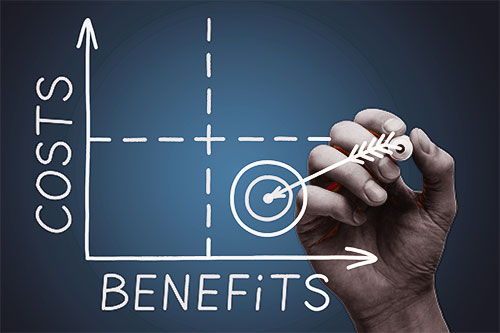More recently and with increasing numbers, organizations are assessing their Total Rewards. What does Total Rewards mean? How does it differ from separately conducting competitive market studies of their compensation levels and their benefits?
WorldatWork, the Total Rewards-focused professional association provides a definition that is embraced by leaders in Compensation and Benefits as well as those across the HR profession:
“Total Rewards encompasses the elements – compensation, well-being, benefits, recognition and development – that, in concert, lead to optimal organizational performance. When designed strategically and executed in alignment with business goals, Total Rewards programs fuel motivated and productive workforces that feel appreciated and rewarded for their contributions, driving the organization to ever greater success.”
 Stating a Meaningful Total Rewards Philosophy
Stating a Meaningful Total Rewards Philosophy
A Total Rewards Philosophy establishes the parameters and guidelines – the “why” and the “how” – your organization intends to reward employees. It also defines the values upon which total rewards should be developed and awarded. It should be informed by consideration of the relevant economic environment, labor market, regulatory issues, community and cultural norms, organizational and HR strategy as well as desired culture. And, it should be championed by leaders, particularly those of Finance, HR and D&I.
Some questions to answer in forming your TR Philosophy:
- To what degree do you want to attain and maintain a market-competitive position?
- Do you strive to be an/the “employer of choice” in your talent markets?
- How would you define your risk-reward approach? To what degree should you emphasize variable/incentive pay versus base salary… or not, and why not?
An Example: Total Rewards Philosophy
To achieve our company’s vision, mission and strategy, we must be able to successfully attract, retain and motivate a diverse team of top-notch talent. Our organization is committed to offering our employees a total rewards package that supports us as an employer of choice in our labor market. Our total rewards offering will be flexible and diverse to changing business and employment situations as well as to meet the diverse needs of our employees. It includes base salary and incentive/performance-based pay, benefits, recognition, development and other non-cash awards. We firmly believe in education and effective, open communication with all employees on their total rewards and our responsibility to assure that our employees know how to take prudent risks within their scope of responsibility. This Total Rewards philosophy applies to all employees of our organization.
Your Total Rewards Philosophy should be communicated broadly as well as contained within your HR Policies and Employee Handbook. With a carefully defined total rewards philosophy, you can next develop your Total Rewards Strategy.
 Developing an Impactful Total Rewards Strategy
Developing an Impactful Total Rewards Strategy
WorldatWork states, “there are six elements of total rewards, each of which includes programs, practices elements and dimensions that collectively define an organization’s strategy to attract, motivate, retain and engage employees.” When we consider the elements that comprise total rewards, we envision general categories of:
- Compensation
- Benefits
- Work-Life Balance
- Performance Management
- Training/Development
- Recognition
For example, under “Compensation” we will see base pay, merit programs/increases, incentive pay/bonuses, etc. “Benefits” may include medical, dental, vision, life and disability insurance, flexible spending accounts, retirement, stock options or phantom stock plans, tuition reimbursement, paid and unpaid time off, etc. Many organizations may include additional benefits such as pet insurance, concierge services, identity protection, adoption assistance, employee and family resources programs, daycare, fitness center membership, reduced mortgage programs, discounted events or home services, etc.
Considering the expense of offering both the statutory and discretionary elements of total rewards, five prudent business questions are:
- Where do we want to be positioned to the external, competitive marketplace in total rewards? What does that mean for base salaries and what does it mean for benefits?
- Why (other than statutory benefits) do we offer what we do?
- Is our total rewards package working “as is,” or do we need to make adjustments?
- What are we getting (i.e., ROI) for these expenses and how do we measure it?
- Given our organizational strategy and its related workforce planning needs during the next 3-5 years, what might we need to rethink in terms of the array of benefits we offer to attract and retain the expertise and caliber of talent we will need?
To ensure that your Total Rewards strategy is effective, it needs to include the following elements:
Ensure your total rewards package supports your organizational goals and objectives – Although it seems logical to assume that, with rewards “more is always better,” the reality is that your total rewards strategy must be supported by a solid business case that defines how each component will support and complement your business objectives. For example, if your organization is poised for rapid growth, then a focused approach on incentive pay may be more important than base pay considerations. Conversely, if retention is an issue, you may want to focus on base salary improvements. Simply stated, your total rewards package will send a clear signal to employees regarding what is important to your organization and its leadership and these need total alignment to your business goals and objectives.
Alignment with organizational culture – If, for example, your culture values a flexible work environment, then a rigid or restrictive policy on paid time off (PTO) or leaves of absence will likely not be an optimal approach. Instead, consider broadly defining or creating generosity (e.g., flexible PTO or a PTO “bank”) in these policies and look for less valued items as a trade-off, if needed.
Nurture an environment where employees are engaged in the development of their total rewards package – Although surveys and focus groups will be helpful (discussed further below), ensure that employees are engaged in the process at every step. Committees and “updating” communications may be an appropriate means to assure a high level of employee involvement and buy-in.
Don’t overlook the intangible (or less tangible) components of your total rewards package – Although it may seem easier to focus on the tangible elements of rewards (e.g., pay and benefits), other elements may be just as important or even more so. Workplace flexibility, enhanced employee decision-making/empowerment, development or promotion opportunity and customer contact may all be critical to the success of your rewards proposition.
Determine how you intend to measure the success of your total rewards package – The measurements or metrics that you choose to monitor the performance of your total rewards package is key. They go hand-in-hand with all of the other elements of your rewards strategy. Compensation percentile and relative comparisons of benefit plans and policies (using market survey data) can provide important and fairly easy-to-obtain measurements. For less tangible components of your package, utilization data, satisfaction surveys, employee turnover and time-to-hire may also be useful measures, depending upon your offering and situation.
How Can We Assess the Efficacy of Our Total Rewards Package?
 Some experts can offer to help you to define what comprises your total rewards package and analyze each total rewards component using various tools and comparisons with market information. Sounds pretty straight-forward, right?
Some experts can offer to help you to define what comprises your total rewards package and analyze each total rewards component using various tools and comparisons with market information. Sounds pretty straight-forward, right?
Actually, this approach falls short of the mark by failing to include the ‘voice of the customer.’ In other words, how can we know if the total rewards package – as employees perceive it – is effective and meaningful, without asking them? To obtain this important information, you will need a well-thought-out and carefully designed needs assessment.
Total Rewards Needs Assessment
A needs assessment is a process for identifying and addressing discrepancies or gaps between current and desired conditions. Discrepancies between the current and desired condition should be measured to appropriately identify the need.
Total Rewards Needs Assessments can be tricky and require a great deal of thought and planning. The tricky aspects of a needs assessment include setting appropriate expectations, asking the right questions for your employees and culture and also choosing the appropriate manner and forum(s) in which to solicit information and feedback. A concise and balanced (for organization and employee) ‘business case’ of why a review is being conducted now is critical.
Clear reassurance about the nature of changes being contemplated as well as those that are ‘off the table’ is well-advised. For example, “as a result of this study:
- No employee’s base salary will be reduced;
- Benefits including medical, life and dental insurance, our retirement plan and all statutory benefits (Social Security, Workers’ Compensation, FMLA, etc.) will continue to be provided by the Company to its employees and their family.”
 A simple survey with a series of questions may not always provide the best data. Data gathering that includes focus groups or interviews, in addition to surveys will gain more robust insights, facilitate follow-up questions to assure deeper grasp of needs and sentiments as well as build stronger, early-stage buy-in to assure your recommendations are as well-received as possible in terms of content and communications upon rollout.
A simple survey with a series of questions may not always provide the best data. Data gathering that includes focus groups or interviews, in addition to surveys will gain more robust insights, facilitate follow-up questions to assure deeper grasp of needs and sentiments as well as build stronger, early-stage buy-in to assure your recommendations are as well-received as possible in terms of content and communications upon rollout.
Issues and Considerations with Total Rewards Needs Assessments
Issue #1: Are employees familiar with their total rewards package, including cost? How recently have you provided total rewards statements? If not within the past year, now is the time.
Consideration: If not, you should consider providing advance information to employees on their perceived total rewards in concise, easy-to-understand terms. Simplicity is key. For instance, rather than just providing a statement that the 401(k) plan provides a 100% match on the first 3% of contributions and the amounts of annual employee/employer contributions, also provide employees with a resource where they can model their retirement income based upon your plan.
Issue #2: If you conduct a needs assessment, you will generate awareness that you are, at a minimum, assessing current status or potentially considering change – which you will want to be perceived as a good thing. However, with this heightened awareness among employees and in asking employees for their input, you will likely create some expectations for which you need to be prepared to respond to in your results, most especially communicating what and why and what not and why not. Participants will want to see that they were ‘heard’ and their suggestions considered.
Consideration: Effective, transparent communications with employees is key. Be cautious to not set expectations that there will be wide-scale change, if that is not feasible. Instead, assure that your messaging reminds employees that it is an assessment. Changes, if any, will need to be evaluated upon results of the internal needs assessment and external competitive market study, in context of organizational strategy, culture and affordability. Change may not be necessary for some or many items. Communicate the results to employees, including areas where no changes are planned.
Issue #3: With surveys, be cautious about asking for open-ended or unconstrained suggestions. Some survey recipients may have a specific or recent issue that causes angst (e.g., base pay) and may cause hyper-focus, to the exclusion of other topics. Others may suggest that improvements to everything are needed – whether or not that is a realistic consideration from a budgetary perspective. If there are some new types of benefits you may be contemplating, it makes sense to inquire staff about their specific importance before incurring the cost. Writing exceptionally clear and direct questions for surveys requires thoughtfulness and careful review.
Consideration: If you simply utilize a survey for data gathering methodology, ask recipients to rank order their priorities, provide preference “weightings” or ask them to divide up a hypothetical budget to each item. However, still include the ability for employees to provide additional, free-form responses. You might be surprised at the creativity and/or items that you did not believe are important, but actually are.
Issue #4: Resist the temptation to “monetize” every component of Total Rewards when communicating a total compensation amount. When communicating certain elements of total rewards to employees, keep in mind that some components of Total Rewards are impractical to which to assign a dollar value within a total compensation calculation. The reasons for this include programs or polices with variable utilization (e.g. sick time, leaves of absence and adoption assistance benefits) as well as employee-paid or low-cost benefits or recognition programs.
Consideration: If you can’t assign a dollar value to a policy or program, instead provide an extensive definition and proposed value in other terms (e.g., comparison to other employer practices or policies). Attempting to monetize everything to construct a total compensation dollar amount will harm your credibility. There are other methods to illustrate the value of a particular element (or several elements) in your total rewards package. For example, you can calculate the approximate value in terms of percentage of average base salary or provide the relative value (e.g., exceeds/competitive/lagging) of your plan, program or policy to surveyed institutions or competitors.
Issue #5: Be cautious of a one-size-fits-all solution. Extensive studies of generational preferences highlight a wide disparity in what employees value in the employer-employee proposition. Emphasis on pay, tuition benefits, retirement plans and work-life balance are just a few examples of where generational, cultural, family structure and other factors or perceptions may vary widely across an organization.
Consideration: Find creative solutions and offer choice and options (where possible) that fit your employee census. For example, student loan/debt benefits are increasing in popularity, especially for recent graduates with high loan balances. How might you provide these benefits to some while being fair and equitable to other employees who have no student debt?
 Since most typically an organization’s top two expense line items are salaries and employee benefits, assuring a strong ROI for your organization is essential. As a general practice, a Total Rewards review should be conducted bi-annually, at a minimum. When you are considering developing or reviewing your Total Rewards program for your institution, remember to start with your philosophy, then develop an appropriate strategy that aligns to your philosophy. Communications, stakeholder buy-in and voice of the customer (i.e., employees) are all critical in every step of the process.
Since most typically an organization’s top two expense line items are salaries and employee benefits, assuring a strong ROI for your organization is essential. As a general practice, a Total Rewards review should be conducted bi-annually, at a minimum. When you are considering developing or reviewing your Total Rewards program for your institution, remember to start with your philosophy, then develop an appropriate strategy that aligns to your philosophy. Communications, stakeholder buy-in and voice of the customer (i.e., employees) are all critical in every step of the process.
If you would benefit from expert assistance with conducting a total rewards assessment or creating a more highly impactful TR strategy or program, please contact us at The Human Resource Consortium (203.495.1500).
For questions related to this article or Total Rewards, Doug Stewart may be reached at dstewart@thehrc.com
By Doug Stewart, Senior Total Rewards & HR Consultant

